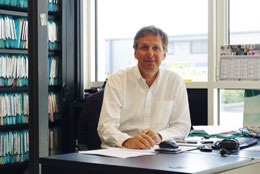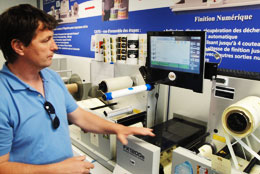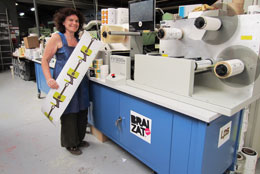Good News for Short Runs
LPS, the company that represents Primera in France, invited several of its customers to its office and workshop in Dourdan close to Paris for a morning of demonstrations and discussions. Etiq & Pack was present.

tiq Lyon does not (yet) fit in the Etiq & Pack Classification of France's top 100 label printers. But this small-scale printer believes he has found a good niche, offering short-run self-adhesive labels. Company owner Bertrand Genin took part in the meeting with LPS in Dourdan.
A converter of blank and thermo-transfer printed labels with just five employees, Etiq Lyon was looking to diversify. Digital printing with its possibility to do short runs, appeared interesting, but among the thirty or more makes and models of digital press, which one to choose? Bertrand Genin does not hide the fact that his first concern was financial: "The was no way we could invest the €300 000 or more needed to install a top-of-the-range rotary digital press. We decided to concentrate on the models selling at less than €100 000. In this price range, there are a number of brands and some very high-performance models. Several times I found a press that seemed just right but which did not have the right converting options. I think that's what first made me look seriously at Primera. Their digital label press prints using a fast laser motor – up to five m/minutes, with a resolution of 2400 dpi that gives pictures, texts andgraphic of very good quality.

Primera, LPS and their customers: Francis Comberton (Speed Etiq), Colette Jullien (Fragrancielles),
Bertrand Genin (Etiq Lyon), Pascal Lambert and Eric Boniface (LPS) and Didier Jouandeau (DTM Print)
In contrast to many other makes, the web remains flat as it passes under the four printheads, which allows much simpler operation. But it is the Primera converting unit that really took my fancy. Very innovative, it comprises coating, die-cutting, matrix rewind and slitting, plus a rewinder for the finished labels. The die-cutting is done using up to four steel knives, which can handle a web speed of six meters/minutes with up to four labels across the web. This is very satisfactory and quite sufficient for the quantities we need to print." Bertrand Genin and his team liked the operating simplicity of this new printing and converting line ("We are far from being experienced print engineers."). Currently Etiq Lyon sells digital labels mostly to its traditional customers. "We are used to bidding for comparatively large quantities of labels, but now, with the Primera line, we are going out to get a maximum of short-run orders – and often the decision-maker within our customer's organisation is not the same person. We are only just starting, and our objective is to get new business by presenting the wealth of possibilities of the digital label."



Different objectives
Francis Comberton, a winegrower from the Bordeaux region, became a label converter almost without wanting to be. He simply noticed that his colleagues in the region had trouble buying small quantities of labels at a reasonable price. Having taken delivery of a Primera printing and converting line in November 2010, he now produces labels principally for test marketing, and for export wines. For "emergency" deliveries he has more difficulty, in that his better established competitors generally own their customers' PDF files and – unfairly perhaps but unsurprisingly – they are not inclined to loan them to third parties!
Colette Jullien is not a label converter, and unlike Francis Comberton, has no ambition to become one. Her company, Fragrancielles, makes a range of perfumes based on essential oils, without synthetic ingredients. With about one hundred different products, the labelling is always a problem. How to have labels that
enhance the product and the brand, that show the legally required information (batch number, use by date, etc.), when an individual batch is rarely more than fifty small bottles? Colette Jullien found the answer to her prayer with a tabletop colour printer from Primera, the LX400e. "Our bottles contain oils and creams," she explains. "And the labels printed on this Primera printer are not
affected by water or oil, once the bottles have been opened."
Braizat Etiquettes
This adhesive label converter from Burgundy, operating four semi-rotary letterpress machines and one screen press, has since February of this year been producing digital labels using the same combination CX1200e + FX1200e. Marie Aubin, the company's owner-manager, found the commissioning of the new printing and converting line very straightforward. "We put this new equipment through its paces, and I can tell you that the labels stand up well to sun and grease, which is very important for certain of our customers. Generally we found we did not need lamination. As for the colours, they stay bright and stand up well to scuffing. The die-cutting is absolutely revolutionary! We have a lot of PR and marketing agencies among our customers – they are just knocked sideways by the possibility of die-cutting a star, heart-shape or any other form." Madame Aubin finds the fact that the press only runs on one web width "not too constraining". On the other hand she finds that the temperature of the drying unit, even if it is well regulated, sometimes causes problems with filmic substrates, and that "you can't use any label stock indiscriminately."
The pros and cons
A recent arrival on the European scene, Primera is based in America and has its European Head Office in Germany. The company has a technology partnership agreement with US-based Lexmark that developed the system of laser printing used by the Primera CX1200e. The other, smaller Primera label presses use inkjet.
Manufactured in the United States, at a time where the US dollar is worth just 67 Euro cents, the Primera equipment and consumables enjoy a substantial price advantage over those of its European competitors. Laser technology is now well established, and in comparison with inkjet it has the
advantage that there are no ducts to get blocked. As with most equipment manufacturers, Primera requires its customers to use only proprietary toners, and strongly advises the use of only approved substrates supplied via its distributors. The customer buys the consumables; there is no "click-charge". The drying unit heats up between 70° and 180° C and when correctly adjusted can handle most substrates (except non-treated PE films). The choice of substrate has sometimes caused problems particularly with non-LPS-approved filmic materials. This is why Pascal Lambert of LPS stresses, "With our twenty years' experience of substrates, we have approved sixteen no-problem substrates which we hold in stock and can deliver rapidly and in the right width."
The only negative points that this
correspondent identified are the
single web width of 216 mm, which can increase material wastage, and the screen monitor that (to misquote Henry Ford) offers any language you like, so long as its English.
DTM Print GmbH: Mainzer Strasse 131, 65187 Wiesbaden/Germany, dtm-print.eu , Phone: +49 611 927770, E-mail: sales@dtm-print.eu

